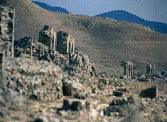 |
From 1965 to 1996 the Tunisian Institute of National
Heritage (INP) and the Rome Section of the German Archaeological Institute
(DAI) set up a programme of research for the ancient quarries and the site
of Chimtou. In its course a Numidian sanctuary in Hellenistic style was
discovered. It was built in the 2nd. cent. B.C.E. on the Sacred Hill of
Chimtou. Its reconstructed Eastern façade forms the central monument
displayed in the Chimtou Museum.
|
| The golden marble of Chimtou was first quarried under Numidian King
Micipsa (149 to 118 B.C.). Under Roman rule, the marble served as decoration
in public buildings all over the empire, especially in Rome itself.
The massive Roman exploitation is responsible for the marvellous scenery offered by the golden Chimtou marble cliffs. For now more than twenty years they are, like the impressive waste dumps, under protection. In course of excavation in the quarry area, the foundations of a Numidian monument were discovered. Around the hill two pagan temples and the remnants of a 5th cent. Christian church were found. |
 |
 |
Most important excavation result was a set of
buildings North of the marble hills, a Roman quarry service camp. At its
center were six halls of a prison for forced labourers, to the East the
quarters of the military watchmen, to the West a complex for the imperial
administration of the quarries.
|
| The marble hills of Chimtou are surrounded by
the site of ancient Simitthus. The joint Tunisian German excavations there
found a cemetery dating from before 400 to 1st cent. B.C. underneath the
Roman forum. The graves were preserved and partly reconstructed. The forum
itself presents its hillside boutiques and, towards the riverside, a forum
basilica and remains of a fountain.
|
 |
 |
On the Majrada river bank lie impressive ruins of a Roman bridge. It is dated into the 3rd and 4th centuries A.D. Attached to it was one of the two known water driven turbine flour mills of Roman North Africa. It operated four shafts. A functioning scaled model of the turbine can be seen in the museum. |
|
Furthermore, remains of many buildings customary to a Roman city still exist. The rests of a small amphitheatre, a theatre , the forum basilica, another three nave basilica and the city baths still stand above ground. |
|
| The water supply of Roman Chimtou was part of the Tunisian German research programme. The aquaeduct drew its water from a small stream dam in the hills to the North. It was 14 kms long. About 2,5 kms before its end it ran through a large subterranean reservoir, which is still fairly well preserved. Towards the town end it rose into a fully bridged aquaeduct ending near the public baths. Many of its arches are still visible. |  |